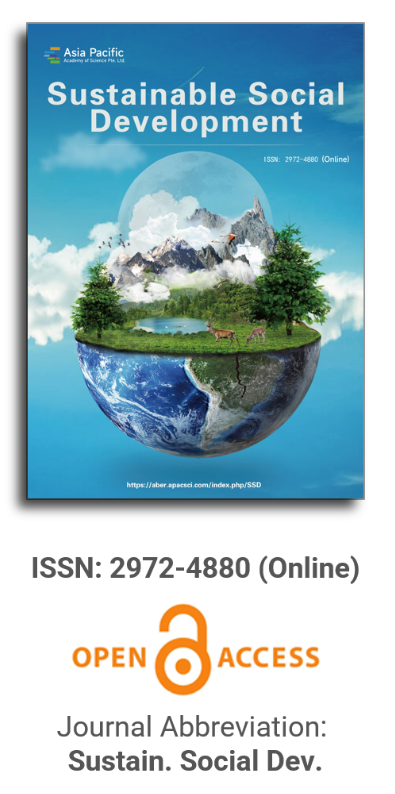
Asia Pacific Academy of Science Pte. Ltd. (APACSCI) specializes in international journal publishing. APACSCI adopts the open access publishing model and provides an important communication bridge for academic groups whose interest fields include engineering, technology, medicine, computer, mathematics, agriculture and forestry, and environment.

Economic complexity of regions and its interrelation with indicators of socio-economic development
Vol 1, Issue 2, 2023
Download PDF
Abstract
The aim of the research is to compare estimates of the economic complexity of the regions obtained on the basis of different data. An approach to assessing the economic complexity of Russian regions by types of economic activity (TEA) is proposed. The approach is based on the standard method of assessing economic complexity. The question of choosing the RCA threshold value is considered. 0-1 matrices are constructed for sectors and TEA at different thresholds. Their structures correctly reflect the idea embedded in the economic complexity index. As a result of the correlation analysis, it is shown that at threshold 1, the index of economic complexity by sector and the index of economic complexity by TEA have greater resistance to changes in the threshold than at other threshold values. A comparative analysis of economic complexity indices constructed for 79 regions by 82 sectors and 24 TEA on the data of 2019 was carried out. Their significant statistical relationship with a number of indicators of socio-economic development characterizing the quality of life has been established. The results of this research can be used to help with building situational models of the economic development of regions as well as to coordinate decisions made by regions when choosing priority areas of their development related to increasing diversification.
Keywords
References
- Afanasiev MY, Ilyin N. New guidelines for choosing priority areas of economic diversification based on the system of situational centers (Russian). Ekonomika I Matematicheskie Metody 2022; 58(4): 29–44. doi: 10.31857/S042473880023017-7
- Afanasiev MY, Kudrov AV, Lysenkova MA. The approach to the diversification of the regional economy taking into account evolutionary conditionality, resource availability and innovation activity. Montenegrin Journal of Economics 2022; 18(2): 7–17. doi: 10.14254/1800-5845/2022.18-2.1
- Fuchs M. The determinants of local employment dynamics in Western Germany. Empirical Economics 2011; 40(1): 177–203. doi: 10.1007/s00181-010-0420-5
- Illy A, Schwartz M, Hornych C, Rosenfeld MTW. Local economic structure and sectoral employment growth in German cities. Journal of Economic and Social Geography 2011; 102(5): 582–593. doi: 10.1111/j.1467-9663.2011.00659.x
- Hausmann R, Rodrik D. Economic development as self-discovery. Journal of Development Economics 2003; 72(2): 603–633. doi: 10.1016/S0304-3878(03)00124-X
- Hausmann R, Hwang J, Rodrik D. What you export matters. Journal of Economic Growth 2007; 12(1): 1–25. doi: 10.1007/s10887-006-9009-4
- Hidalgo CA, Hausmann R. The building blocks of economic complexity. Proceedings of the National Academy of Sciences 2009; 106(26): 10570–10575. doi: 10.1073/pnas.0900943106
- Lubimov IL, Gvosdeva MA, Kazakova MV, Nesterova KV. Complexity of the economy and possibility of export diversification in Russian regions (Russian). Zhurnal Novoy Ekonomicheskoy Assotsiatsii 2017; 34(2): 94–122. doi: 10.31737/2221-2264-2017-34-2-4
- Afanasiev MY, Kudrov AV. Economic complexity and embedding of regional economies’ structures (Russian). Ekonomika I Matematicheskie Metody 2021; 57(3): 67–78. doi: 10.31857/S042473880016410-0
- Afanasiev MY, Gusev AA. Approximation of estimates of economic complexity when choosing priority areas of diversification (Russian). Tsifrovaya Ekonomika 2022; 17(1): 52–59. doi: 10.34706/DE-2022-01-05
- Hausmann R, Klinger B. Structural transformation and patterns of comparative advantage in the product space. Available online: http://www.tinyurl.com/2bdm7aml (accessed on 5 September 2023).
- Sciarra C, Chiarotti G, Ridolfi L, Laio F. Reconciling contrasting views on economic complexity. Nature Communications 2020; 11(1): 3352. doi: 10.1038/s41467-020-16992-1
- Hartmann D, Guevara MR, Jara-Figueroa C, et al. Linking economic complexity, institutions, and income inequality. World Development 2017; 93: 75–93. doi: 10.1016/j.worlddev.2016.12.020
- Aivazian SA, Afanasiev MY, Kudrov AV. Method of clustering of regions of the Russian Federation taking into account the sectoral structure of GRP (Russian). Prikladnaya Ekonometrika 2016; 41(1): 24–46.
- Hidalgo C. Why information grows: The evolution of order, from atoms to economies. The Review of Austrian Economics 2015; 30: 147–151. doi: 10.7551/mitpress/9647.001.0001
- Afanasiev MY. New guidelines for the digital economy: On the relationship between economic complexity and material well-being (Russian). Bulletin of the CEMI RAS 2022; 5(1): 1–10. doi: 10.33276/S265838870019868-7
- Aivazian SA, Afanasiev MY, Kudrov AV. Indicators of economic development in the basis of characteristics of regional differentiation (Russian). Prikladnaya Ekonometrika 2018; 50(2): 4–22.
- Aivazian SA, Afanasiev MY, Kudrov AV. Methodology of socio-economic development assessment given the characteristics of regional differentiation. Model Assisted Statistics and Applications 2020; 15(4): 311–314. doi: 10.3233/MAS-200502
Supporting Agencies
Copyright (c) 2023 Mikhail Yu. Afanasiev, Aleksei A. Gusev
License URL: https://creativecommons.org/licenses/by/4.0/

This site is licensed under a Creative Commons Attribution 4.0 International License (CC BY 4.0).

Prof. Kittisak Jermsittiparsert
University of City Island, Cyprus






It is with deep regret that we announce the cancellation of the Forum on Sustainable Social Development & Computing and Artificial Intelligence, originally scheduled for June 15, 2025.

